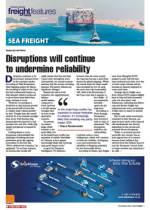Disruption continues to be the primary demand driver in the container market. According to Niels Rasmussen, chief shipping analyst for Bimco, the rerouting of ships via the Cape has had a substantial impact on ship demand, which is projected to grow three times faster than cargo volumes in 2024. "However, we anticipate a slowdown in ship demand growth in the second half of 2024 due to weaker cargo volume growth," he said. "Despite this, the overall outlook for 2024 remains stronger than 2023, with forecast ship demand growth expected to end between 15% and 16%, while ship supply is projected to expand by 10. 3%."Looking ahead to 2025, Rasmussen acknowledged the challenges of making accurate predictions given the ongoing uncertainty in the Red Sea. "We’ve outlined two scenarios," he explained. "In our base scenario, we assume that vessels will safely resume Red Sea and Suez Canal routes throughout 2025. Alternatively, our second scenario assumes that the current rerouting patterns will persist without any significant changes."Rasmussen said in both scenarios, the supply/demand balance would weaken compared to 2024, however it would remain stronger than in 2023 in the alternative scenario.“A t pr e s e n t , we cannot judge which scenario is the more likely, but as the Israel/Gaza conf lict has expanded to include Hezbollah in Lebanon, it does appear increasingly likely that rerouting may partly impact 2025.”A report by Transport Intelligence (Ti) indicates, however, that the route around the Cape has become a semi-fixed feature for global shipping. “While the transit times for cargo vessels have increased by 50% in total, the sector has coped reasonably well. Such is the functioning of the Cape route that it appears to be a viable – if not necessarily desirable – option for the long term.”According to Fitch Ratings, disruptions have persisted with no sign of abatement. The disruptions underline the vulnerability of global trade to route chokepoints, which will continue to limit the visibility of shipping costs and undermine the reliability of shipping schedules for the foreseeable future.According to Bimco, spot freight rates from Shanghai (SCFI) peaked in early July but have since declined more than 30% due to lower cargo volumes and an increase in capacity deployed in some trade lanes. “Average export freight rates from China (CCFI) peaked slightly later in July and have decreased only 15% since then,” said Rasmussen, indicating that Bimco expected further freight rate reductions into 2025, particularly if ships were to return to normal routings. But, he said, much uncertainty remained in their forecast, not least because much of the demand side development was directly dependent on the current and potential future disruptions. “Risks to economic growth naturally also remain, but at least appear less of a concern because lower inf lation has allowed both the Federal Reserve and the European Central Bank to begin interest rate reductions,” he said. LV

